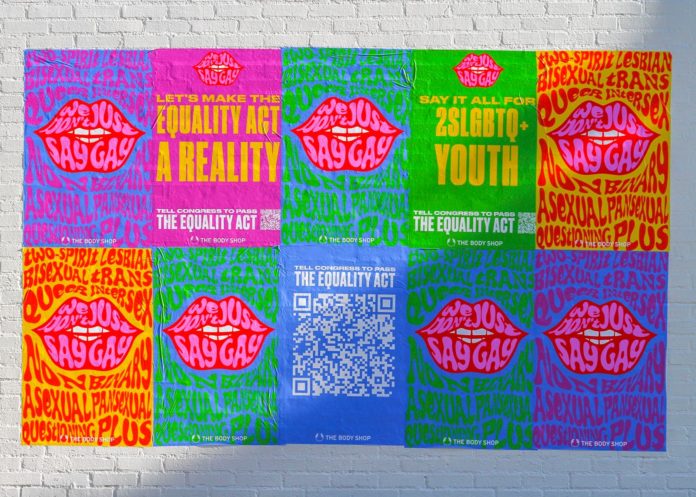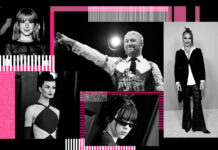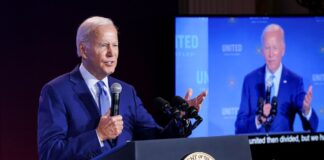Campaign Trail is our analysis of some of the best new creative efforts from the marketing world. View past columns in the archives here.
This year, Pride Month celebrations occurred amid a rising tide of anti-LGBTQ hate, violence and discrimination, including the passage of Florida’s Parental Rights in Education Act — the so-called “Don’t Say Gay Bill” — which goes into effect today. In this fraught climate, brands hoping to show support of the LGBTQ community needed to step up their purpose-driven efforts or risked being painted with the “rainbow-washing” brush by cynical consumers.
Leading the way last month was The Body Shop, which launched a campaign that continued the beauty brand’s decades-long activist streak by directly pushing back against “Don’t Say Gay” and encouraging consumers to make their voices heard.
Across retail signage, outdoor advertising and other channels, The Body Shop proclaimed, “We Don’t Just Say Gay,” listing a variety of sexual orientations and gender identities like trans, queer, non-binary and more, including the lesser-known “two-spirit” identity adopted by some Indigenous North Americans. Instead of the familiar, rainbow-colored graphics of many Pride-focused brand campaigns, The Body Shop’s in-store and out-of-home signage utilized the bold, vibrant colors, bubbly fonts and graphical style of the flower-power 1960s.
“Having a poster that is in your face and is talking about all of the identities that need to be part of the conversations… and really getting to the emotional core of how people are feeling about this is amazing for this organization to do,” said Libby Brockhoff, co-founder and CEO of Odysseus Arms, the agency behind the effort.
“Our agency is heavily into graphics that weaponize whatever messages that we want to use, but I think that it remains timeless and positive and cheerful,” she added.

Out-of-home ads by The Body Shop go beyond “just” saying gay and call for support of the Equality Act.
Courtesy of The Body Shop
Rather than the red and black colors favored by some politically charged artists and advertising, the ads embrace beauty and celebration by using The Body Shop’s brand activist colors — an element of its visual identity that most brands don’t have in their style guide.
“The bold accent colors used in our Pride campaign are inspired by our activist heritage. These colors bring a sense of radical, yet joyful, energy to our campaigns, and are only used for loud, impactful messaging,” said Hilary Lloyd, vice president of marketing and corporate social responsibility for The Body Shop.
Odysseus Arms uses a creative and strategic method it calls Third3ye to better integrate consumer insights into its campaigns to ensure that they are authentic, responsible and inclusive.
“Consumers told us they have really high expectations of The Body Shop to think a little bit more thoughtfully about it, and not go out and say ‘We say gay,’ but realize that there’s so many other people that need to be represented in this conversation,” Brockhoff said.
The retro style’s resonance with consumers was another insight gleaned from Odysseus Arms’ Third3ye method and helped contextualize this moment in the history of activism, establishing it as the heir to the freedom, love and acceptance celebrated by the hippies of the late ’60s and early ’70s that challenged traditional views of sexuality.
“The true insight here is we don’t just say gay — we want to hold space for the broader, wider community and make sure they feel safe and protected,” Lloyd added.
A brand defined by activism
Along with the signage, the campaign also includes other elements meant to support real world change. QR codes connect consumers to the digital Pride Hub, which features resources and connects to a petition hosted by the brand’s charitable partners: Advocates for Youth in the U.S. and It Gets Better Canada. In the U.S., the petition will automatically generate a letter to senators urging support of the Equality Act, a piece of federal legislation that would safeguard LGBTQ rights.
The brand will also donate $1 of every sale of its “Out for Love” highlighter makeup range to the organizations — up to $10,000 for each group — through August 31. Taken together, the campaign elements demonstrate The Body Shop’s holistic approach to purpose.
“It’s a perfect partnership between our core brand values around fighting for a fairer and more beautiful world, our perspective on inclusion and our history in the space, and our creative partners who are thoughtful in developing content, all supported by real, authentic calls to action,” Lloyd said.
Purpose-driven marketing has become something of a buzzword in the advertising world, with many brands walking just up to the line of politically charged arenas while perhaps not tackling an issue like the surge in anti-LGBTQ legislation. The Body Shop’s long legacy of purpose-driven work makes such actions easier.
“Long before ‘purpose driven’ was something that brands defined themselves by, we were already occupying that space,” she said. “That gives us the courage and enables us to be brave in terms of tackling these types of issues and really dedicating ourselves to being an advocate or platform for creating meaningful change in the world.”
Along with its consumer-facing actions, The Body Shop also applies its activism to its own business, creating programs, networks and forums focused on inclusion and inclusivity, along with partnerships with organizations that help educate the brand on how to be authentic in building inclusion strategies. The company views corporate social responsibility through the lens of activism, and even has an activism lead inside the business.
“Our North Star is that to exist in a fairer world, we want to be a beauty business that facilitates change,” Lloyd explained. “If that’s the North Star, then you have to bravely step into that territory, which to be honest with you, I don’t think is particularly brave. I think it’s table stakes for us.”








